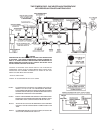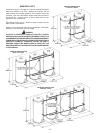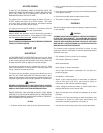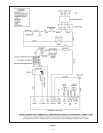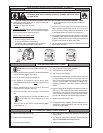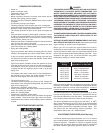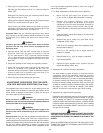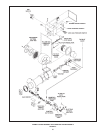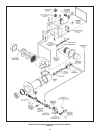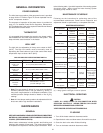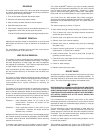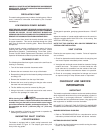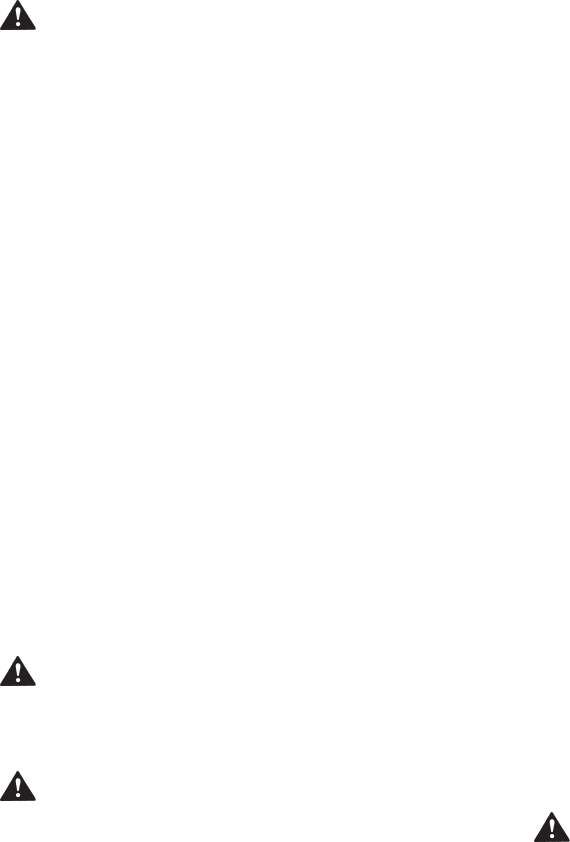
24
1. Check gas line pressure with a manometer.
Set initial gas line pressure at 9-10” w.c. before turning the
heater “ON”.
Read gas line pressure and gas manifold pressure when
the heater main gas is “ON”.
Adjust gas line regulator setting if the gas line pressure drops
below 8” w.c. when heater main gas is “ON”.
Check heater gas manifold pressure (see Table 10) using a
manometer connected to the manifold pressure tap on the
Robertshaw gas control valve, see Figure 10.
Important Note: Use gas manifold pressure as initial setup
only. The final air and gas settings should be based on fire rate
and flue gas 0
2
/C0
2
reading, see Table 10 for normal 0
2
/C0
2
reading.
WARNING
Excessive gas line pressure drop and/or burner manifold
pressure too low may cause burner start/operate with
excessive noise!
2. Cycle the burner “ON” and “OFF” several times to check its
operation. Make sure the gas line pressure is below
14” w.c. when burner is “OFF”. If gas line pressure exceeds
14” w.c. when the burner is off, the gas supply line size must
be increased to correct this problem (see Table 9 for gas
pipe size).
3. Check the operation of the limiting and operating controls.
4. Check the vent system seams and joints and ensure that
there is no discharge of flue products into the room. For
standard vertical vent systems, check the barometric damper
control to make sure it operates freely and there is no
discharge of flue products into the room.
5. Check the input rate by clocking the gas meter.
ADJUSTMENT PROCEDURE FOR FIRE-RATE,
LOW NOX AND HIGH ELEVATION (Fine-Tune)
An acceptable input rate is within 2% of the rated input for the
model. Should it be necessary to adjust the gas pressure to the
burner and/or air damper of the blower to obtain the full input
rate, these steps should be followed:
WARNING
Never set burner combustion too lean (causing noisy
operation) or too rich (causing combustion chamber premature
failure) see Table 10 for proper settings.
WARNING
Never set air damper outside of its adjustment range of the
rated fire rate unless authorized by an A.O. Smith Service
Center.
Important Note: Final gas and air settings should be based on
flue gas CO
2
or O
2
reading (see Table 10). Increase burner
manifold pressure will increase fire rate and flue gas CO
2
reading.
Increase air damper setting will decrease fire rate and decrease
flue gas CO
2
reading. Adjustable air damper is preset for the
rated fire-rate prior to delivery, should not be re-adjusted unless
it’s a high elevation application and/or a direct vent (long air
intake vent) application.
1. Fire Rate Adjustment (including direct vent installation).
a. Make sure the gas supply line pressure reads
8” w.c. (2 kPa) or higher when the heater is running.
b. Remove the pressure regulator cover screw
(Figure 10) and adjust the pressure by tuning the
adjustment screw w/a small screwdriver clockwise to
increase gas pressure into the burner and fire rate.
Counterclockwise to decrease gas pressure and input
rate.
c. Clock gas meter, repeat above Step (b) to achieve the
specific input rate.
d. Measure flue gas O
2
and/or CO
2
(see Table 10) for
acceptable O
2
/CO
2
range.
If the O
2
or CO
2
reading is within the acceptable range,
then proceed to Step (f).
If the O
2
or CO
2
reading is out of range, adjust air
damper is required.
e. Repeat Steps (b), (c), (d) if air damper is adjusted.
f. Cycle heater ON/OFF.
g. Replace the gas regulator cover, pressure tap and
tighten the damper center bolt.
2. Adjustment for Low NOx Emission Application.
The water heater is preset at factory for Low Nox emission
combustion. Due to the installation variations, fine-tune
adjustments may be required. To lower NOx emission level
(30PPM corrected at 3% O
2
or lower is required by SCAQMD),
air damper setting may need to be slightly increased. To
increase air damper setting, loosen the center nut of the inlet
air damper, rotate the damper clockwise slightly, then tighten
the center nut. After re-set the air damper, cycle heater
ON/OFF and check fire-rate and flue gas CO
2
/O
2
reading.
3. Adjustment for High Elevation Application
Installation above 2000 feet sea level require new air damper
settings. All the final settings should be based on flue gas
CO
2
/O
2
reading, see Table 10. To increase air damper setting,
loosen the center bolt of the inlet air damper, rotate the damper
clockwise slightly, then tighten the center bolt. After re-setting
the air damper, cycle heater ON/OFF and check fire-rate and
flue gas CO
2
/O
2
reading.
WARNING
UNDER NO CIRCUMSTANCES SHOULD THE INPUT RATE EXCEED
THE INPUT RATE SHOWN IN THE HEATER RATING PLATE.
OVERFIRING COULD RESULT IN DAMAGE OR SOOTING OF THE
HEATER.
SHOULD OVERHEATING OCCUR OR THE GAS SUPPLY FAIL
TO SHUT OFF, TURN OFF THE MANUAL GAS CONTROL VALVE
TO THE APPLIANCE.




